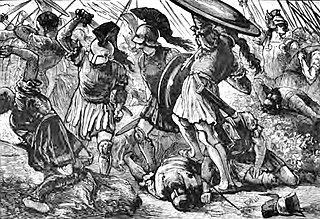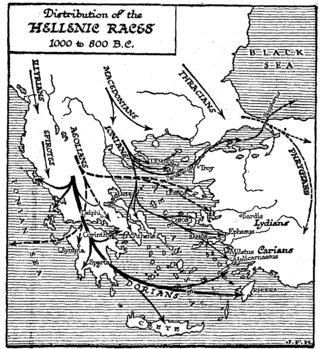
The Dorians were one of the four major ethnic groups into which the Hellenes of Classical Greece divided themselves. They are almost always referred to as just "the Dorians", as they are called in the earliest literary mention of them in the Odyssey, where they already can be found inhabiting the island of Crete.

This is a timeline of ancient Greece from its emergence around 800 BC to its subjection to the Roman Empire in 146 BC.

Boeotia, sometimes Latinized as Boiotia or Beotia is one of the regional units of Greece. It is part of the region of Central Greece. Its capital is Livadeia, and its largest city is Thebes.
Eurysthenes was king of Sparta and one of the Heracleidae in Greek mythology. He was a son of Aristodemus and Argia, daughter of Autesion. He had a twin brother, Procles. Together they received the land of Lacedaemon after Cresphontes, Temenus and Aristodemus defeated Tisamenus, the last Achaean king of the Peloponnesus. Eurysthenes married Lathria, daughter of Thersander, King of Kleonae, sister of his sister-in-law Anaxandra, and was the father of his successor, Agis I, founder of the Agiad dynasty of the Kings of Sparta.

Aetolia is a mountainous region of Greece on the north coast of the Gulf of Corinth, forming the eastern part of the modern regional unit of Aetolia-Acarnania.
The Battle of Tanagra was a land battle that took place in 457 BC between Athens and Sparta during the First Peloponnesian War. Tension between Athens and Sparta had built up due the rebuilding of Athens' walls and Spartan rejection of Athenian military assistance. The Athenians were led by Myronides and held a strength of 14,000. The Spartans were led by Nicomedes and had a total of 11,500 soldiers. Both sides suffered losses; however, the Spartans left victorious.
In Archaic Greece, an amphictyony, or amphictyonic league, was an ancient religious association of tribes formed before the rise of the Greek poleis.

The Battle of Chaeronea was fought in 338 BC, near the city of Chaeronea in Boeotia, between Macedonia under Philip II and an alliance of city-states led by Athens and Thebes. The battle was the culmination of Philip's final campaigns in 339–338 BC and resulted in a decisive victory for the Macedonians and their allies.

Amfissa is a town in Phocis, Greece, part of the municipality of Delphi, of which it is the seat and a municipal unit. The municipal unit has an area of 315.174 km2. It lies on the northern edge of the olive forest of the Crissaean plain, between two mountains, Giona to the west and Parnassus to the east, 200 km (120 mi) northwest of Athens and 20 km (12 mi) of Delphi, as well as 85 km (53 mi) northeast of Naupactus and 72 km (45 mi) south of Lamia.

Doris is a small mountainous district in ancient Greece, bounded by Aetolia, southern Thessaly, the Ozolian Locris, and Phocis. It is the original homeland of the Dorian Greeks. It lies between Mounts Oeta and Parnassus, and consists of the valley of the river Pindus (Πίνδος), a tributary of the Cephissus, into which it flows not far from the sources of the latter. The Pindus is now called the Apostoliá. This valley is open towards Phocis; but it lies higher than the valley of the Cephissus, rising above the towns of Drymaea, Tithronium, and Amphicaea, which are the last towns in Phocis.
The First Peloponnesian War was fought between Sparta as the leaders of the Peloponnesian League and Sparta's other allies, most notably Thebes, and the Delian League led by Athens with support from Argos. This war consisted of a series of conflicts and minor wars, such as the Second Sacred War. There were several causes for the war including the building of the Athenian long walls, Megara's defection and the envy and concern felt by Sparta at the growth of the Athenian Empire.

The Locrians were an ancient Greek tribe that inhabited the region of Locris in Central Greece, around Parnassus. They spoke the Locrian dialect, a Doric-Northwest dialect, and were closely related to their neighbouring tribes, the Phocians and the Dorians. They were divided into two geographically distinct tribes, the western Ozolians and the eastern Opuntians; their primary towns were Amphissa and Opus respectively, and their most important colony was the city of Epizephyrian Locris in Magna Graecia, which still bears the name "Locri" to this day. Among others, Ajax the Lesser and Patroclus were the most famous Locrian heroes, both distinguished in the Trojan War. Zaleucus from Epizephyrian Locris devised the first written Greek law code, the Locrian code.

Opuntian Locris or Eastern Locris was an ancient Greek region inhabited by the eastern division of the Locrians, the so-called tribe of the Locri Epicnemidii or Locri Opuntii.
The Third Sacred War was fought between the forces of the Delphic Amphictyonic League, principally represented by Thebes, and latterly by Philip II of Macedon, and the Phocians. The war was caused by a large fine imposed in 357 BC on the Phocians by the Amphictyonic League, for the offense of cultivating sacred land; refusing to pay, the Phocians instead seized the Temple of Apollo in Delphi, and used the accumulated treasures to fund large mercenary armies. Thus, although the Phocians suffered several major defeats, they were able to continue the war for many years, until eventually all parties were nearing exhaustion. Philip II used the distraction of the other states to increase his power in northern Greece, in the process becoming ruler of Thessaly. In the end, Philip's growing power, and the exhaustion of the other states, allowed him to impose a peaceful settlement of the war, marking a major step in the rise of Macedon to pre-eminence in Ancient Greece.

The history of Sparta describes the history of the ancient Doric Greek city-state known as Sparta from its beginning in the legendary period to its incorporation into the Achaean League under the late Roman Republic, as Allied State, in 146 BC, a period of roughly 1000 years. Since the Dorians were not the first to settle the valley of the Eurotas River in the Peloponnesus of Greece, the preceding Mycenaean and Stone Age periods are described as well. Sparta went on to become a district of modern Greece. Brief mention is made of events in the post-classical periods.
Onomarchus was general of the Phocians in the Third Sacred War, brother of Philomelus and son of Theotimus. After his brother's death he became commander of the Phocians and pursued a warmongering policy until his final defeat.

The following outline is provided as an overview of and topical guide to ancient Greece:

The regions of ancient Greece were areas identified by the ancient Greeks as geographical sub-divisions of the Hellenic world. These regions are described in the works of ancient historians and geographers, and in the legends and myths of the ancient Greeks.
This page lists topics related to ancient Greece.











